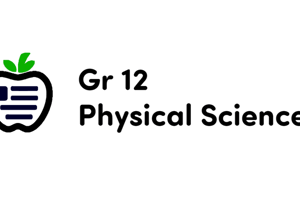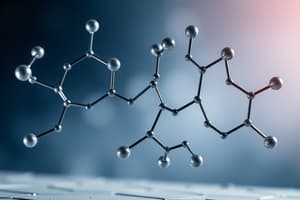Podcast
Questions and Answers
What is defined as a molecule that has a non-superimposable mirror image?
What is defined as a molecule that has a non-superimposable mirror image?
- Conformational isomer
- Achiral molecule
- Chiral molecule (correct)
- Racemate
Which type of carbon atom is referred to as a chiral carbon or stereocentre?
Which type of carbon atom is referred to as a chiral carbon or stereocentre?
- One connected to a double bond
- One with two identical groups attached
- One in a linear arrangement
- One with four different groups attached (correct)
How do enantiomers affect plane polarized light?
How do enantiomers affect plane polarized light?
- Both rotate it in the same direction
- One rotates it clockwise and the other counterclockwise (correct)
- Neither affects the plane of polarized light
- They rotate it based on their molecular weight
What is a racemic mixture?
What is a racemic mixture?
What does the designation (+) represent when naming enantiomers?
What does the designation (+) represent when naming enantiomers?
Which enantiomer designations correspond to actual geometry in relation to glyceraldehyde?
Which enantiomer designations correspond to actual geometry in relation to glyceraldehyde?
What defines isomers?
What defines isomers?
What can cause racemization of an enantiomer in the body?
What can cause racemization of an enantiomer in the body?
Which of the following is an example of structural isomers?
Which of the following is an example of structural isomers?
What was a significant consequence of using thalidomide during pregnancy?
What was a significant consequence of using thalidomide during pregnancy?
What is a stereogenic centre?
What is a stereogenic centre?
In the context of geometric isomers, what does the term 'cis' refer to?
In the context of geometric isomers, what does the term 'cis' refer to?
What distinguishes enantiomers from other isomers?
What distinguishes enantiomers from other isomers?
How do chirality and superimposable images relate to each other?
How do chirality and superimposable images relate to each other?
What are geometric isomers known for?
What are geometric isomers known for?
In cyclic compounds, what feature allows the existence of stereoisomers?
In cyclic compounds, what feature allows the existence of stereoisomers?
What label is given to an enantiomer if the priority of the substituent groups on the chiral carbon decreases in the clockwise direction?
What label is given to an enantiomer if the priority of the substituent groups on the chiral carbon decreases in the clockwise direction?
In which situation would an enantiomer be labeled as S?
In which situation would an enantiomer be labeled as S?
Which of the following represents the common names used for enantiomers of limonene?
Which of the following represents the common names used for enantiomers of limonene?
Which of the following pairs are enantiomers?
Which of the following pairs are enantiomers?
Which factor determines the priority of the substituent groups on a chiral carbon?
Which factor determines the priority of the substituent groups on a chiral carbon?
What structure is commonly used to illustrate the geometry and labels of enantiomers?
What structure is commonly used to illustrate the geometry and labels of enantiomers?
Which of the following correctly represents enantiomers based on their configurational labels?
Which of the following correctly represents enantiomers based on their configurational labels?
Which compound is mentioned as being rich in carvone?
Which compound is mentioned as being rich in carvone?
What distinguishes diastereomers from enantiomers?
What distinguishes diastereomers from enantiomers?
Which of the following correctly describes carvone and its types?
Which of the following correctly describes carvone and its types?
Which statement is true about olfactory receptors in humans?
Which statement is true about olfactory receptors in humans?
In the example of glucose and galactose, what type of isomers are they?
In the example of glucose and galactose, what type of isomers are they?
What is the outcome when a molecule has multiple stereocenters in terms of isomers?
What is the outcome when a molecule has multiple stereocenters in terms of isomers?
Flashcards are hidden until you start studying
Study Notes
Isomers
- Isomers are molecules with the same chemical formula but different atom arrangements.
- They exhibit distinct physical and chemical properties despite having identical formulas.
Types of Isomers
-
Structural Isomers
- Molecules share the same atoms but differ in their bonding structure.
- Example: Butane and Isobutane have varied properties due to different bonding.
-
Stereoisomers
- Atoms are bonded in the same manner but differ in spatial arrangement.
- The location of the arrangement difference is known as the stereogenic centre.
Geometric Isomers
- Found in alkenes, where the positioning of groups around a C=C double bond creates different isomers.
- Cis Isomer: Similar groups on the same side of the double bond.
- Trans Isomer: Similar groups on opposite sides of the double bond.
- Example: Butene illustrates the differences in physical properties between cis and trans forms.
Cyclic Stereoisomers
- Occur in cyclic compounds, leading to isomerism.
- Example: 1,2-dimethylcyclohexane shows cis and trans arrangements of methyl groups.
Optical Isomers and Chirality
- Chirality: Non-superimposable mirror images indicate a chiral molecule.
- Achiral: Superimposable mirror images signify an achiral structure.
- Chiral Carbon: A carbon atom with four different substituents creates enantiomers.
Enantiomers
- Non-superimposable mirror images of a molecule.
- Have similar physical properties in achiral environments but differ significantly in chiral environments, affecting biological activity.
- Optical activity measured with a polarimeter; enantiomers rotate polarized light in opposite directions (+ clockwise, - counterclockwise).
Racemization
- The process that produces a racemic mixture with equal proportions of enantiomers.
- One enantiomer might be biologically active while the other inactive, potentially causing side effects.
Naming Enantiomers
- (+) vs. (-): Named based on the direction of light rotation (dextrorotatory vs. levorotatory).
- D vs. L: Based on spatial configuration relative to glyceraldehyde.
- (R) vs. (S): Assigned according to priorities of substituent groups on chiral carbon (clockwise vs. counterclockwise).
Examples of Enantiomers
- Limonene
- Hydrocarbon found in citrus peels, comprising D-limonene (+) and L-limonene (-).
- Carvone
- Found in essential oils, with D-carvone (+) and L-carvone (-), highlighting their distinct smells.
Diastereomers
- Isomers that differ at one or more (but not all) stereocentres without being mirror images.
- Example: Glucose and Galactose demonstrate diastereomerism.
- Molecules with multiple stereocentres may have both enantiomers and diastereomers among them.
Summary of Enantiomers vs. Diastereomers
- Enantiomers: Non-superimposable mirror images, affect polarization differently.
- Diastereomers: Not mirror images, may have different physical properties, but are more complex in their configurations.
Studying That Suits You
Use AI to generate personalized quizzes and flashcards to suit your learning preferences.




